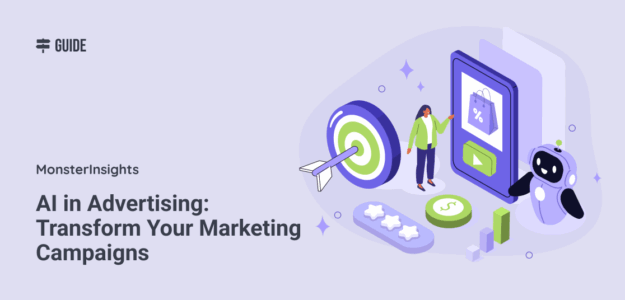Traditional advertising used to be a guessing game. You’d create an ad, pick where to place it, and hope for the best. But those days of throwing money at the wall and seeing what sticks are over. AI in advertising has completely changed that.
Since AI, marketers can target the right people, create better content, and spend their budgets more wisely than ever before. Instead of relying on hunches, you can now use data and machine learning to make smarter decisions about every aspect of your campaigns.
I’ve been watching this transformation happen firsthand, and the results are impressive. Companies using AI for their advertising are seeing conversion rates jump while cutting their costs at the same time.
In this article, I’ll walk you through exactly how AI is reshaping advertising, what tools you should consider, and how to get started without getting overwhelmed.
Table of Contents:
What Is AI in Advertising?
AI in advertising uses artificial intelligence and machine learning to automate and improve your marketing campaigns. Think of it as having a super-smart assistant that can analyze millions of data points in seconds and make decisions about who should see your ads, when they should see them, and what those ads should say.
The technology goes beyond simple automation. It actually learns from every interaction, getting smarter with each campaign you run. This means your second campaign will perform better than your first, and your tenth will be even more effective.
AI advertising differs from traditional marketing methods because, instead of creating a single ad for everyone, AI can generate thousands of variations tailored to specific audiences. It can adjust your spending in real-time based on performance. And it can predict which customers are most likely to buy from you before you even show them an ad.
Pro Tip: You don’t need to understand the complex technical details to benefit from AI advertising. Focus on learning how the tools work and what results they can deliver for your business.
Why You Need AI for Advertising Right Now
The advertising world has become incredibly complex. You’re competing for attention across dozens of platforms, each with its own audience behaviors and best practices. Manual management simply can’t keep up anymore.
Consider this: 61.4% of marketers have already incorporated AI into their marketing strategies. They’re not doing this because it’s trendy. They’re doing it because it works.
AI solves three major problems that every advertiser faces today.
Budget Waste
Without AI, you’re essentially making educated guesses about where to spend your money.
You might put $1,000 into Facebook ads and $1,000 into Google ads, then compare the results after a month. AI can make those allocation decisions in real-time, moving money to the best-performing channels automatically.
Scale Limitations
Creating personalized ads for different audience segments used to require huge teams and massive budgets. AI can generate thousands of ad variations instantly, each one tailored to specific demographics, interests, or behaviors.
Data Overload
Modern advertising platforms generate enormous amounts of data. A single campaign might produce hundreds of metrics across multiple channels. Humans can’t process this information fast enough to make timely optimizations. AI thrives on this complexity.
The companies ignoring AI are falling behind fast. 75% of companies using AI for marketing have seen an increase in customer engagement. Your competitors are already using these marketing tools to outperform traditional approaches.
To learn more, check out Your Complete Guide to AI-Optimized PPC Campaigns.
Key Components of AI Advertising
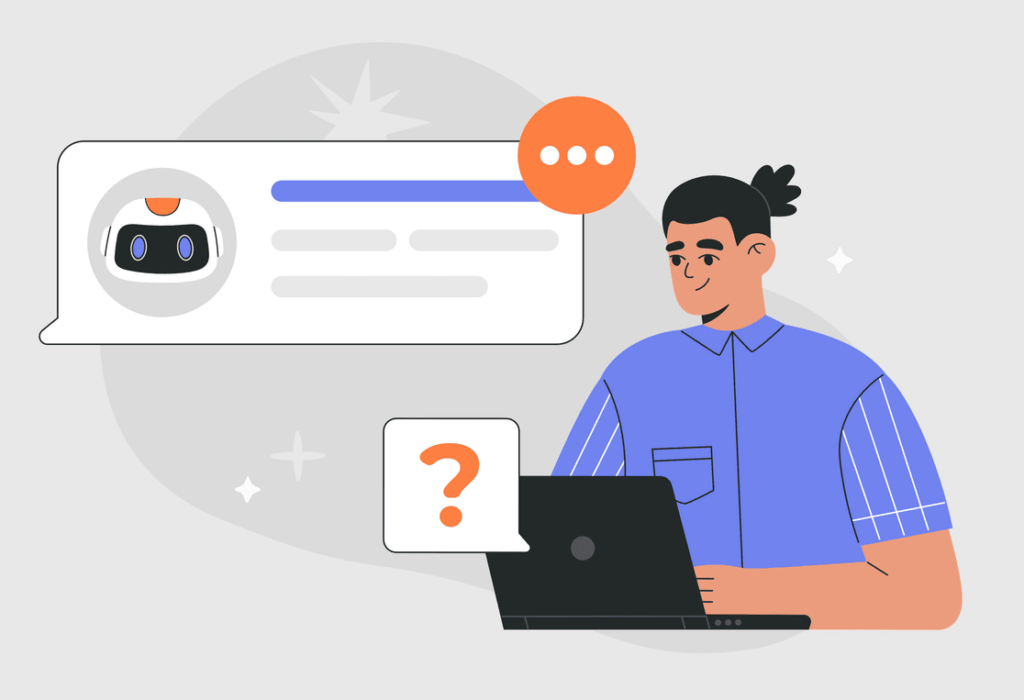
Understanding the building blocks of AI advertising will help you make better decisions about which tools to use and how to implement them.
Machine Learning: The Brain Behind Everything
Machine learning is what makes AI advertising truly powerful. It’s constantly analyzing your campaign data to find patterns you’d never notice on your own.
For example, it might discover that your ads perform 40% better on Tuesday afternoons, or that customers from certain zip codes are three times more likely to make large purchases. These insights become the foundation for better targeting and timing decisions.
Data Analysis: Your Campaign Intelligence
Every click, view, and conversion generates data. AI advertising platforms use this information to build detailed profiles of your best customers and identify lookalike audiences.
The AI analysis goes deeper than basic demographics. AI can determine that someone who visits your pricing page twice and reads your blog is 85% likely to become a customer within the next two weeks. This level of insight lets you adjust your messaging and timing accordingly.
Automated Optimization: Real-Time Improvements
While you’re sleeping, AI is working. It’s testing different ad placements, adjusting bids based on performance, and shifting budget between campaigns to improve your overall results.
This automation happens much faster than any human could manage. AI can make thousands of micro-adjustments per day, each one designed to improve your return on investment.
Personalization: Speaking to Individual Customers
73% of consumers now expect brands to cater to their unique needs and expectations. AI makes this level of personalization possible at scale.
Instead of showing the same ad to everyone, AI can customize the message, images, and even the products featured based on each person’s browsing history, previous purchases, and predicted interests.
Predictive Analytics: Seeing the Future
AI doesn’t just analyze what happened. It predicts what will happen next. This means you can identify customers who are likely to churn before they leave, or spot trends in your market before your competitors do.
These predictions help you allocate resources more effectively and stay ahead of changing customer behaviors.
How to Get Started with AI Advertising
Starting with AI advertising doesn’t require a computer science degree or a massive budget. Here’s the step-by-step approach I recommend.
Step 1: Choose Your First Platform
Begin with the advertising platform where you already spend the most money. If that’s Google Ads, start with their Smart Bidding features. If it’s Facebook, experiment with their automated audience targeting.
Don’t try to implement AI across all your channels at once. Pick one platform, learn how the AI features work, and measure the results before expanding.
Step 2: Set Up Proper Tracking
AI needs data to work effectively. Make sure you have conversion tracking set up correctly on your website. This means tracking not just purchases, but also email signups, phone calls, and other valuable actions.
If you’re on WordPress, use tools like MonsterInsights to simplify your Google Analytics setup and get better data for your AI campaigns.
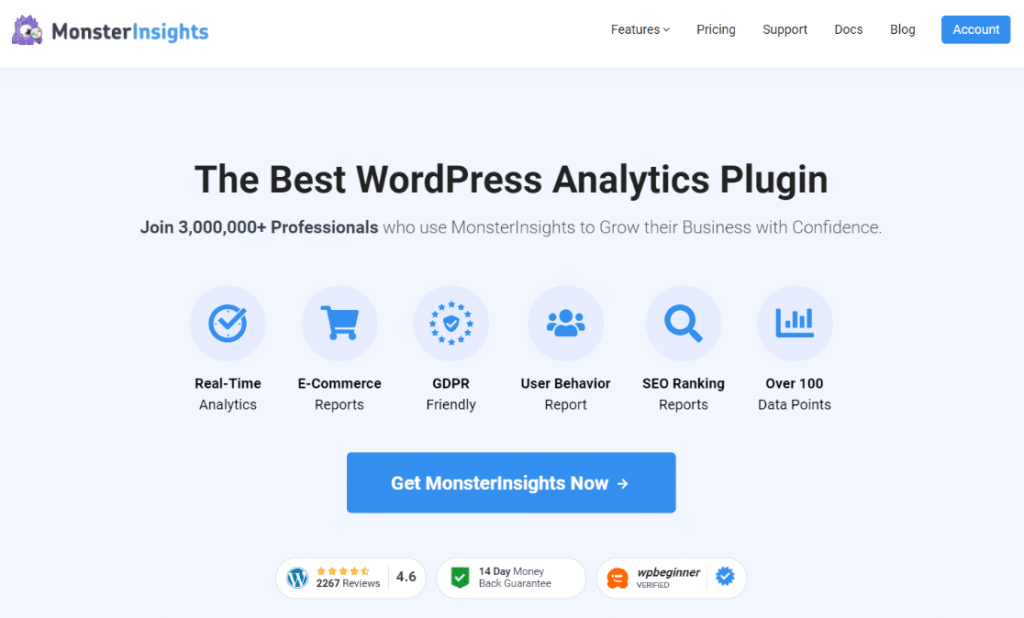
Most businesses struggle with PPC conversion tracking. Google’s conversion code can be complex to install, and many companies end up tracking only basic conversions like purchases. This gives AI incomplete data to work with.
MonsterInsights solves this problem by letting you:
- Install conversion tracking without writing any code
- Track all types of conversions: purchases, form submissions, phone calls, file downloads
- View your PPC performance directly in your WordPress dashboard
- Give AI systems complete data about what’s actually working
The result? Your AI campaigns optimize based on all your conversions, not just the ones Google can automatically detect. This leads to better targeting and improved return on ad spend.
But here’s where it gets really interesting. MonsterInsights also includes Conversations AI, which combines your analytics data with artificial intelligence in one dashboard. Instead of digging through complex reports, you can simply ask questions like:
- “How are my Google Ads performing this month?”
- “Which campaigns are driving the most revenue?”
- “What’s my cost per conversion for Facebook ads?”
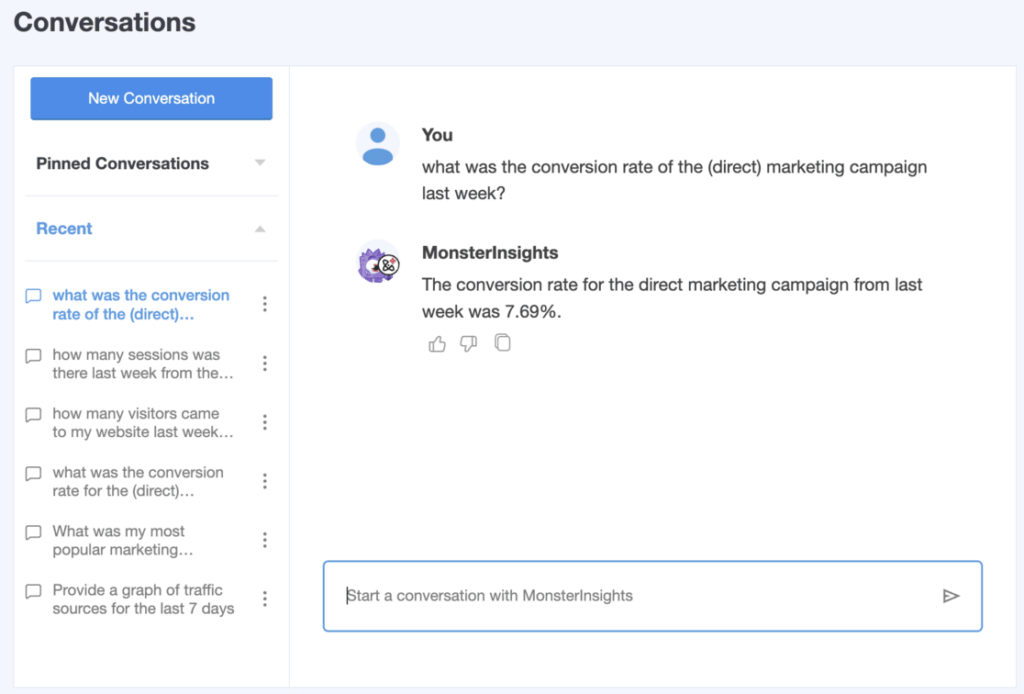
Conversations AI instantly analyzes your data and provides clear answers. This means you can spot optimization opportunities faster and make data-driven decisions about your AI advertising campaigns without becoming a Google Analytics expert.
Step 3: Start with Automated Bidding
Most advertising platforms offer automated bidding as an entry point to AI. These systems adjust your bids in real-time to help you achieve specific goals, like maximizing conversions or maintaining a target cost per acquisition.
Start conservative. Set clear performance goals and let the AI optimize toward those targets. You can always expand to more advanced features once you see positive results.
Step 4: Experiment with Dynamic Ads
Dynamic ads automatically show different products or services to different people based on their interests and behaviors. They’re particularly effective for eCommerce businesses with large product catalogs.
Here’s how they actually work in practice. Let’s say you run an online clothing store. With traditional ads, you might create one ad showing a generic “Shop Our Clothes” message. With dynamic ads, someone who looked at running shoes on your website sees an ad featuring running shoes, while someone who browsed dresses sees an ad with dresses.
The setup can be technical, but the results are worth it. Dynamic ads typically see 20-30% higher click-through rates compared to static alternatives.
Step 5: Test AI-Generated Content
44% of marketers have implemented AI for marketing content production. Start small by using AI to generate subject lines for your email campaigns or ad headlines for testing.
Tools like ChatGPT or specialized marketing AI platforms can create dozens of variations quickly. Test these against your human-written copy to see what performs better.
Real Examples of AI Advertising Success
Seeing how other companies use AI advertising successfully can give you ideas for your own campaigns.
Coca-Cola’s Creative AI Initiative
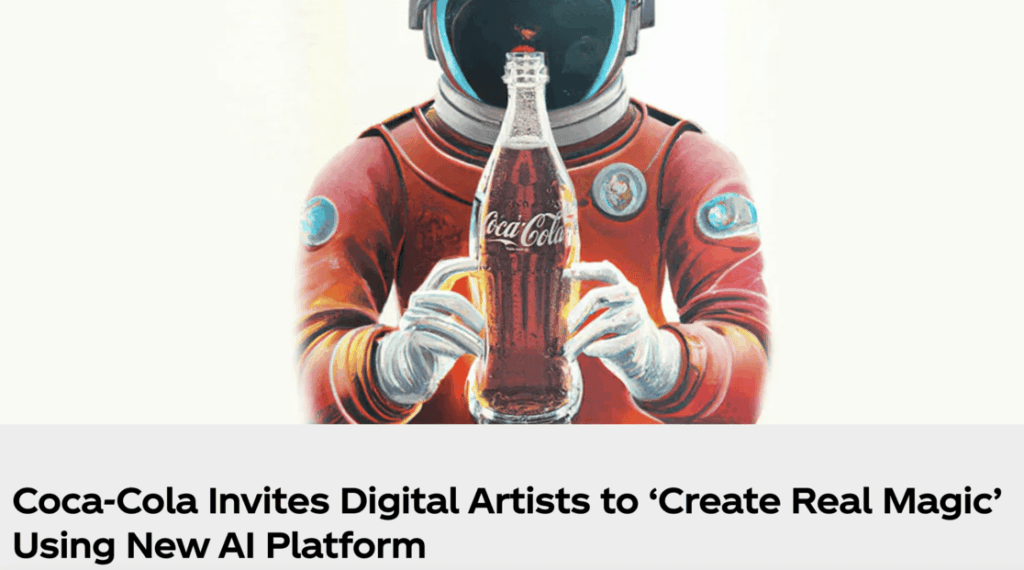
Coca-Cola partnered with OpenAI to create their “Create Real Magic” campaign. They invited customers to use ChatGPT and DALL-E to create new artwork featuring classic Coca-Cola advertising elements.
The campaign generated massive engagement and user-generated content while positioning Coca-Cola as an innovative brand. More importantly, it gave them valuable data about customer preferences and creative directions.
Netflix’s Hyper-Personalization
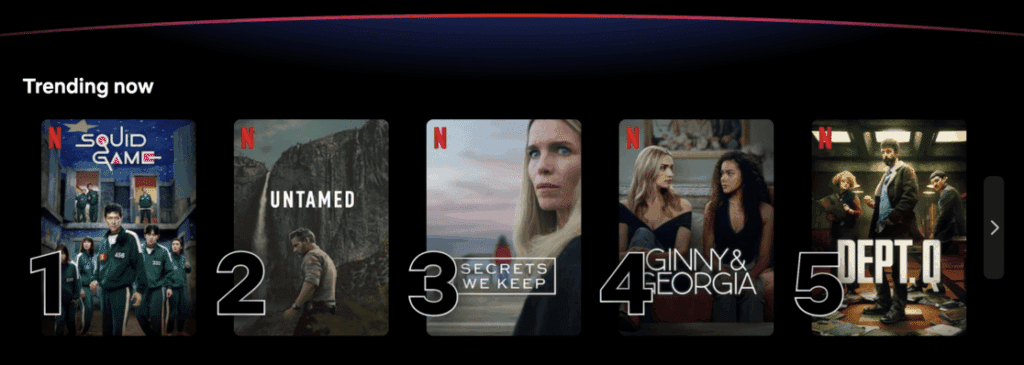
Netflix uses AI to personalize not just what shows they recommend, but even the thumbnail images you see. The same movie might show different images to different users based on their viewing history.
This level of personalization has helped Netflix maintain low churn rates and high engagement. Users feel like the platform truly understands their preferences.
JPMorgan Chase’s Copy Optimization
Chase used AI platform Persado to rewrite their marketing copy and saw up to a 450% increase in click-through rates. The AI-generated headlines and messaging that human copywriters wouldn’t have thought to try.
This shows how AI can complement human creativity rather than replace it. The best results often come from combining human strategy with AI execution.
Nike’s Historical Innovation

Nike created an AI-generated advertisement showing tennis star Serena Williams playing against her younger self. The campaign celebrated both Nike’s 50th anniversary and Williams’ career achievements.
The video generated millions of views and demonstrated how AI can create emotionally compelling content that would be impossible to produce any other way.
Best AI Advertising Tools to Consider
The right tools can make the difference between AI advertising success and frustration. Here are the platforms I recommend based on different needs and budgets.
For Beginners: Platform Built-In AI
Start with the AI features already available in your current advertising platforms:
- Google Ads Smart Bidding and Responsive Search Ads
- Facebook’s Automated Placements and Dynamic Ads
- LinkedIn’s Automated Bidding and Audience Expansion
These tools are free to use and integrate seamlessly with your existing campaigns.
For Content Creation:
- ChatGPT: Great for generating ad copy, email subject lines, and social media content
- DALL-E or Midjourney: Create unique images and visual assets for your campaigns
- Copy.ai: Specialized for marketing copy with templates for different industries
For Advanced Campaign Management:
- Persado: Uses AI to optimize marketing language for better emotional response
- Albert: Autonomous digital marketing platform that manages campaigns across multiple channels
- Omneky: Generates personalized ad content at scale across different platforms
For Analytics and Insights:
- MonsterInsights: Simplifies Google Analytics data and provides AI-powered insights
- Crimson Hexagon: AI-powered consumer insights and sentiment analysis powered by Brandwatch
Pro Tip: Don’t try to use every AI tool at once. Pick one or two that solve your biggest current challenges, master those, then expand your toolkit gradually.
Future Trends in AI Advertising
Understanding where AI advertising is headed can help you prepare for upcoming changes and opportunities.
Voice Search Optimization
45% of Americans use voice search technology during their shopping journeys. AI will become crucial for optimizing ads for voice queries, which tend to be longer and more conversational than typed searches.
Real-Time Personalization
AI will enable even more granular personalization, adjusting ad content based on factors like weather, time of day, current events, and real-time behavior patterns.
Cross-Platform Intelligence
Future AI systems will better understand customer journeys across multiple devices and platforms, providing a more complete picture of how your marketing efforts work together.
Predictive Customer Lifetime Value
AI will get better at predicting not just whether someone will convert, but how valuable they’ll be as a long-term customer. This will help you make smarter decisions about acquisition spending.
Creative Generation
AI-generated video content, interactive ads, and immersive experiences will become more sophisticated and cost-effective, making high-quality creative accessible to businesses of all sizes.
And that wraps it up!
I hope you liked this article on using AI in advertising. Be sure to also check out:
PPC Campaign Optimization: Complete Guide to Boost Your ROI
AI Search Engine Optimization: The Complete Ranking Guide
PPC Competitor Analysis: How to Outperform Your Competition
How to Track Meta (Facebook) Ads in Google Analytics Easily
Not using MonsterInsights yet? Get started today!
Also, follow us on YouTube for the latest Google Analytics and WordPress tips and tutorials.
FAQs
How much does AI advertising cost?
Many AI advertising features are built into existing platforms like Google Ads and Facebook at no additional cost. Specialized AI tools can range from $50 per month for basic features to thousands for enterprise solutions. Start with platform built-in features before investing in separate tools.
Do I need technical skills to use AI advertising?
No, most modern AI advertising tools are designed for marketers, not programmers. Platforms like Google Ads and Facebook have made their AI features accessible through simple interfaces. You can start benefiting from AI without any coding knowledge.
Will AI replace human marketers?
AI handles data processing and optimization tasks, but human creativity, strategy, and relationship-building remain essential. The most successful AI advertising campaigns combine machine efficiency with human insight and creativity.
How long does it take to see results from AI advertising?
Initial improvements often appear within 2-4 weeks as AI systems gather data and optimize performance. However, the most significant benefits typically develop over 2-3 months as the AI learns more about your audience and market.
Can small businesses compete with large companies using AI?
Yes, AI actually levels the playing field in many ways. Small businesses can access the same optimization technologies that large companies use, often with lower complexity and overhead. Focus on one platform initially and expand gradually.
